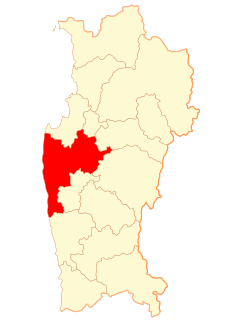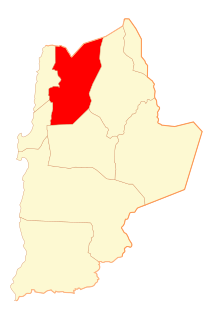Related Research Articles
Sing may refer to: To sing is to produce musical sounds with a voice.
The Argentine Interconnection System is a wide area synchronous grid that links the regional networks of all Argentinian provinces, with the exception of Tierra del Fuego. It is also connected to the power grids of several neighboring countries.
The electricity sector in Argentina constitutes the third largest power market in Latin America. It relies mostly on thermal generation and hydropower generation (36%). The prevailing natural gas-fired thermal generation is at risk due to the uncertainty about future gas supply.
As of August 2020 Chile had diverse sources of electric power: for the National Electric System, providing over 99% of the county's electric power, hydropower represented around 26.7% of its installed capacity, biomass 1.8%, wind power 8.8%, solar 12.1%, geothermal 0.2%, natural gas 18.9%, coal 20.3%, and petroleum-based capacity 11.3%. Prior to that time, faced with natural gas shortages, Chile began in 2007 to build its first liquefied natural gas terminal and re-gasification plant at Quintero near the capital city of Santiago to secure supply for its existing and upcoming gas-fired thermal plants. In addition, it had engaged in the construction of several new hydropower and coal-fired thermal plants. But by July 2020 91% of the new capacity under construction was of renewable power, 46.8% of the total solar and 25.6% wind, with most of the remainder hydro.
Colbún is a utility company in Chile engaged in the electric power transmission segment. The company was created in 1982 and privatized in 1997. Originally it had only two hydroelectric plants, Machicura and Colbún from where it gets its name. Today Colbún S.A. generates a total of 2514 MW, of which 1274 comes from hydropower and 1236 from fossil fuels plants. Colbún S.A. supplies the Sistema Interconectado Central power grid that spans Zona Central and Zona Sur but is currently developing a controversial joint venture project with ENDESA, called HidroAysén, to create five hydroelectrical power plants in Aisén Region.
The Sistema Interconectado Central or SIC is the main alternating current power grid in Chile spanning all of Chile from Atacama Region in the north to Los Lagos Region in the south. SIC transmits 68.5% of the national generation and serves 93% of Chile's population.
The Sistema Eléctrico de Magallanes or SEM is an alternating current power grid serving the Magallanes and Antartica Chilena Region of Chile. All of the SEM's power generation is produced by combustion of fossil fuels in thermal power plants, some of the fuel comes from the oilfields in the Strait of Magellan. SEM's power generation stands currently for about 0.8% of the national generation. The communes of Antártica and Cabo de Hornos, including Puerto Williams are not connected to the system.
The Sistema Eléctrico de Aysén (SEA) is an alternating current power grid serving the Aysén del General Carlos Ibáñez del Campo Region of Chile. It is operated by a private company called EDELAYSEN, whose motto is La Luz del Sur.
E-CL is a Chilean utility company based in Santiago and formerly known as Empresa Electrica Del Norte Grande or Edelnor. The company, which changed its name in 2010, was founded in 1981 with contributions from the Empresa Nacional de Electricidad SA (Endesa) and the Corporacion de Fomento de la Produccion (CORFO).
AES Andes S.A., formerly AES Gener S.A., is a producer and distributor of electricity based in Santiago, Chile. It is a subsidiary of American Company AES Corporation which operates in South America's Andes region.
Chile represents one of the largest undeveloped geothermal areas of the world. Despite Chile's good economic performance in the late 1980s and 1990s, geothermal energy did not develop, and Chile has been surpassed by other Latin American countries such as El Salvador and Costa Rica in terms of geothermal development and technology. Currently, Chile has only one geothermal power plant.
The electricity sector in Venezuela is one of the few in the world to rely primarily on hydroelectricity, which accounted for 64% in 2015.

The total installed solar power in Brazil was estimated at about 14 GW at March 2022, generating approximately 2.48% of the country's electricity demand, up from 0.7% in 2018. In 2020, Brazil was the 14th country in the world in terms of installed solar power.
In 2018 Chile produced about 7% of its electricity from solar power. As of year end, it had 2137 MW of solar PV capacity. In July 2020 installed solar capacity had risen to 3104 MW, with another 2801 MW under construction.

Talinay Wind Farm, also known by its official name of Parque Eolico Talinay, is a wind farm in northern Chile, located in the region of Coquimbo near the city of Ovalle. It has an installed capacity of 90 MW and is capable of generating about 200 GWh annually, which is set to be expanded to 500 MW in the future, with a second wind park Parque Eolico Talinay II adding a further 500 MW.

The Taltal wind farm is a wind energy project in northern Chile. The farm is named after the commune of Taltal, where the project is located, in the region of Antofagasta, 1,550 km (960 mi) north of Santiago. The plant's connection to the Chilean electricity grid was reported on 5 December 2014. The name "Taltal" came from the indigenous word Thalthal, which means "night bird".

María Elena Solar Power Plant is a concentrated solar power plant with a molten-salt technology system that is currently under construction in the commune of María Elena in the Antofagasta Region of Chilé.

Cerro Dominador Solar Power Plant is a 210-megawatt (MW) combined concentrated solar power and photovoltaic plant located in the commune of María Elena in the Antofagasta Region of Chile, about 24 kilometres (15 mi) west-northwest of Sierra Gorda. The project was approved by the Chilean government in 2013 and construction was started by Abengoa Solar Chile, a branch of the multinational Abengoa Spain. The plant has been inaugurated on June 8, 2021. A follow up project called Likana Solar bid $33.99/MWh in an auction in August 2021.
Renewable energy in Chile is classified as Conventional and Non Conventional Renewable Energy (NCRE), and includes biomass, hydro-power, geothermal, wind and solar among other energy sources. Most of the time, when referring to Renewable Energy in Chile, it will be the Non Conventional kind.

Chapiquiña power plant is a hydroelectric power plant in northern Chile. It takes water from the Canal Lauca and produces electrical power through a Pelton turbine.
References
- ↑ SING installed capacity. Central Energía. Retrieved: 15-05-2012